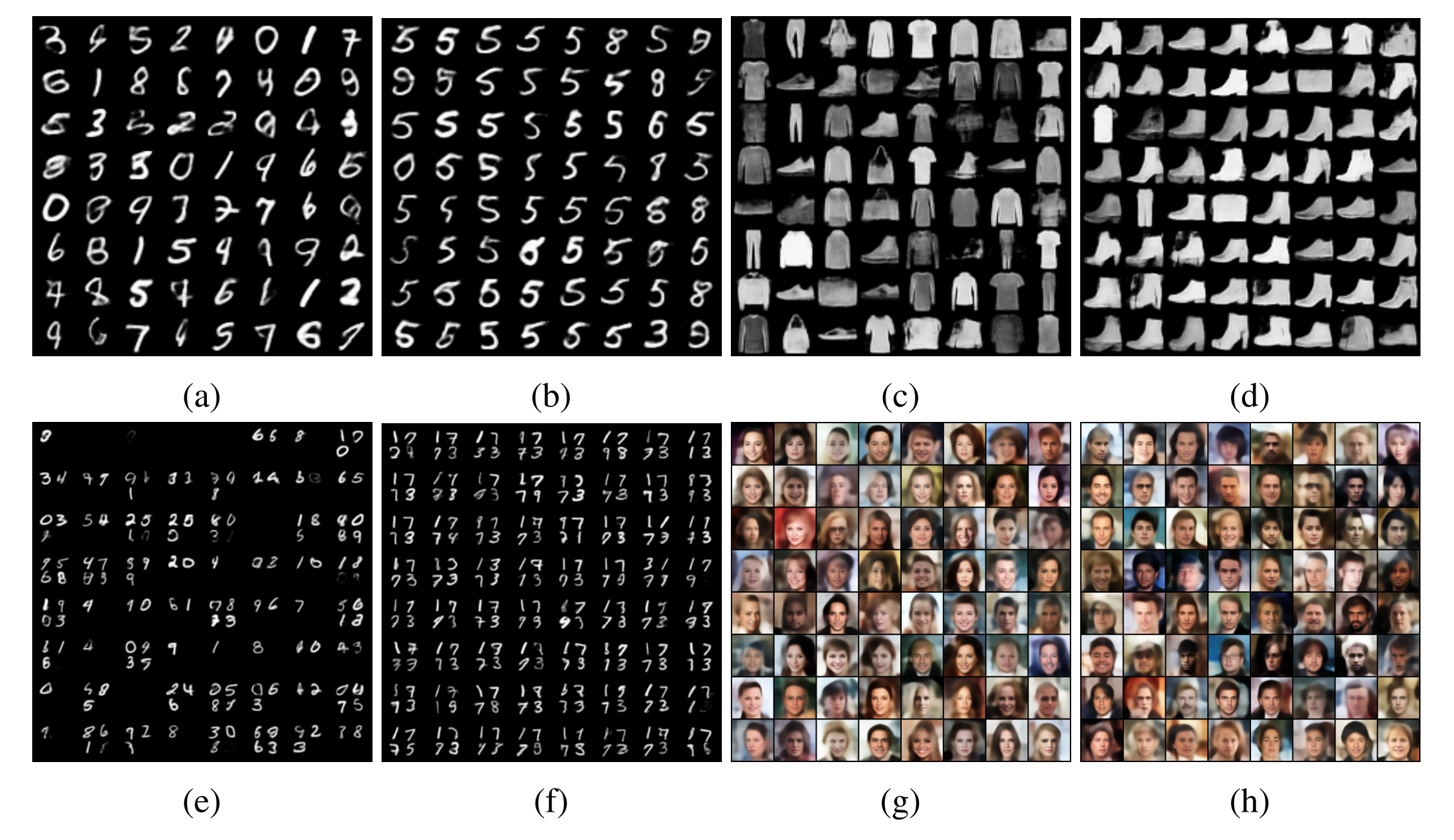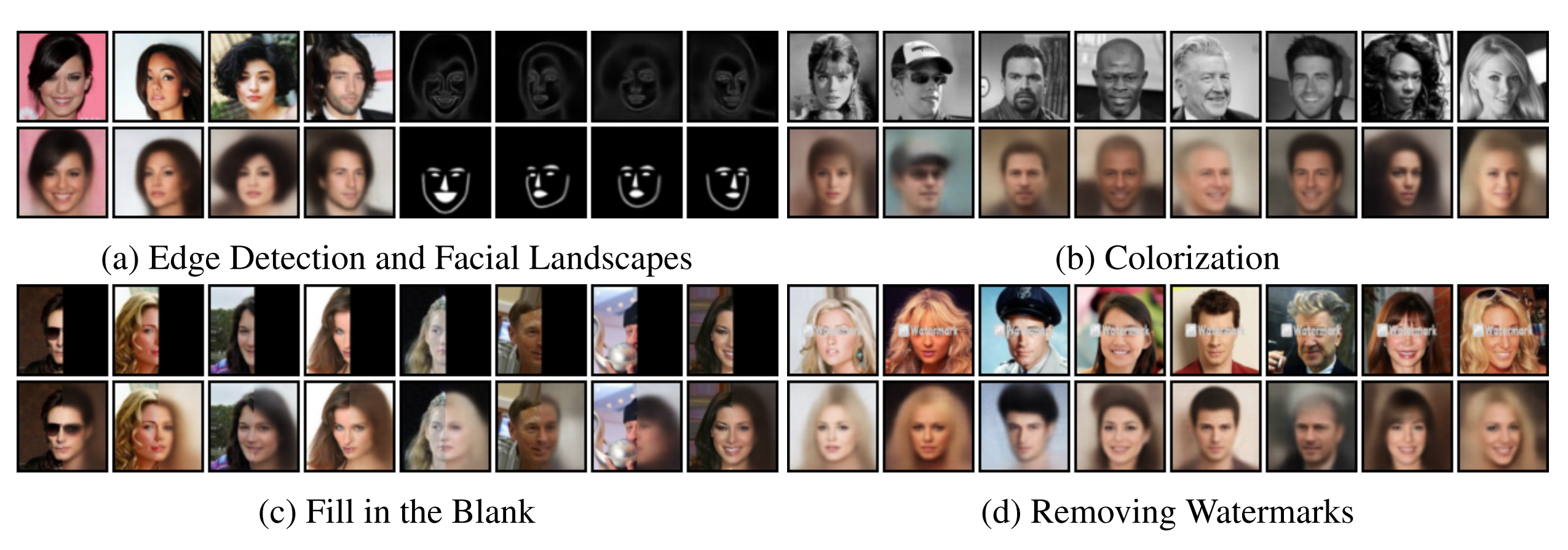A PyTorch implementation of Multimodal Generative Models for Scalable Weakly-Supervised Learning (https://arxiv.org/abs/1802.05335).
Open a new conda environment and install the necessary dependencies. See here for more details on installing dlib.
conda create -n multimodal python=2.7 anaconda
# activate the environment
source activate multimodal
# install the pytorch
conda install pytorch torchvision -c pytorch
pip install tqdm
pip install scikit-image
pip install python-opencv
pip install imutils
# install dlib
brew install cmake
brew install boost
pip install dlib
Some additional setup is needed for CelebA-related datasets. Download the aligned-and-cropped version here. Also download any annotation information. For the computer vision experiment, we need to precompute a few computations on the CelebA dataset. The dlib model we use to extract landmarks is from a PyImageSearch tutorial. You can download it here. After downloading CelebA, try the following:
cd vision
# assuming CelebA images are stored in ./data/images
python setup.py grayscale ./data/images ./data/grayscale
python setup.py edge ./data/images ./data/edge
python setup.py mask ./data/images ./data/mask
This repository contains a subset of the experiments mentioned in the paper. In each folder, there are 3 scripts that one can run: train.py to fit the MVAE; sample.py to (conditionally) reconstruct from samples in the latent space; and loglike.py to compute the marginal log likelihood log p(x) using q(z|x,y) as the inference network.
By default, we anneal KL from 0 to 1. The user can customize the learning rate (--lr), number of latent dimensions (--n-latents), te annealing rate (--annealing-epochs), etc. from the command line. Notably, the user can set lambda_image and lambda_text, which balance the reconstruction terms. This tends to be important in practice. Training the model will save weights to filesystem. Run python train.py -h for details.
Treat images as one modality and the label (integer 0 to 9) as a second.
cd mnist
CUDA_VISIBLE_DEVICES=0 python train.py --lambda-text 50. --cuda
# model is stored in ./trained_models
CUDA_VISIBLE_DEVICES=0 python sample.py ./trained_models/model_best.pth.tar --cuda
# you can also condition on the label
CUDA_VISIBLE_DEVICES=0 python sample.py ./trained_models/model_best.pth.tar --condition-on-text 5 --cuda
Very similar to MNIST, except the labels correspond to categories of fashion items.
cd fashionmnist
CUDA_VISIBLE_DEVICES=0 python train.py --lambda-text 50. --cuda
# model is stored in ./trained_models
CUDA_VISIBLE_DEVICES=0 python sample.py ./trained_models/model_best.pth.tar --cuda
# you can also condition on the label
CUDA_VISIBLE_DEVICES=0 python sample.py ./trained_models/model_best.pth.tar --condition-on-text 1 --cuda
Again, a MNIST-derivative except each image contains up to 4 digits in fixed locations. The second modality is a string of digits representing the character(s) in the image. We employ an RNN in the label inference network q(z|y).
cd multimnist
CUDA_VISIBLE_DEVICES=0 python train.py --lambda-text 10. --cuda
# model is stored in ./trained_models
CUDA_VISIBLE_DEVICES=0 python sample.py ./trained_models/model_best.pth.tar --cuda
# you can also condition on the digits
CUDA_VISIBLE_DEVICES=0 python sample.py ./trained_models/model_best.pth.tar --condition-on-text 1773 --cuda
Treat images of celebrity faces as one modality and 18 attributes pertaining to the celebrity (i.e. gender, hair color, etc) as a second modality.
cd celeba
CUDA_VISIBLE_DEVICES=0 python train.py --lambda-attrs 10. --cuda
# model is stored in ./trained_models
CUDA_VISIBLE_DEVICES=0 python sample.py ./trained_models/model_best.pth.tar --cuda
# you can also condition on the attribute
CUDA_VISIBLE_DEVICES=0 python sample.py ./trained_models/model_best.pth.tar --condition-on-attrs Male --cuda
Similar to CelebA except we treat each attribute as its own expert in the product-of-experts. Here we begin to explore more than 2 modalities. See code for an example of the MVAE training paradigm (mentioned in the paper) by sampling multimodal ELBO terms.
cd celeba
CUDA_VISIBLE_DEVICES=0 python train.py --lambda-attrs 10. approx-m 1 --cuda
Here approx-m sets the number of ELBO terms to sample beyond the complete and individual terms.
We learn a series of image processing transformations (i.e. colorization, image completion, edge detciont, watermark removal, and facial landmark segmentation) as modalities. We curate a dataset by applying off-the-shelf tools to CelebA. For simplicitly, in this implementation, we only include the complete ELBO term (using all 6 modalities), and the 6 individual ELBO terms as the objective (in order words k = 0). One can also subsample more ELBO terms to better approximate the true MVAE objective (as in /celeba19/train.py).
cd vision
CUDA_VISIBLE_DEVICES=0 python train.py --cuda
# model is stored in ./trained_models
CUDA_VISIBLE_DEVICES=0 python sample.py ./trained_models/model_best.pth.tar --cuda
# this will reconstruct all the modalities from the image
CUDA_VISIBLE_DEVICES=0 python sample.py ./trained_models/model_best.pth.tar --condition-file <path_to_file> --condition-type image --cuda
# we can also go in the other directions
CUDA_VISIBLE_DEVICES=0 python sample.py ./trained_models/model_best.pth.tar --condition-file <path_to_file> --condition-type watermark --cuda
Please report any bugs and I will get to them ASAP. For any additional questions, feel free to email me@mikehwu.com.

